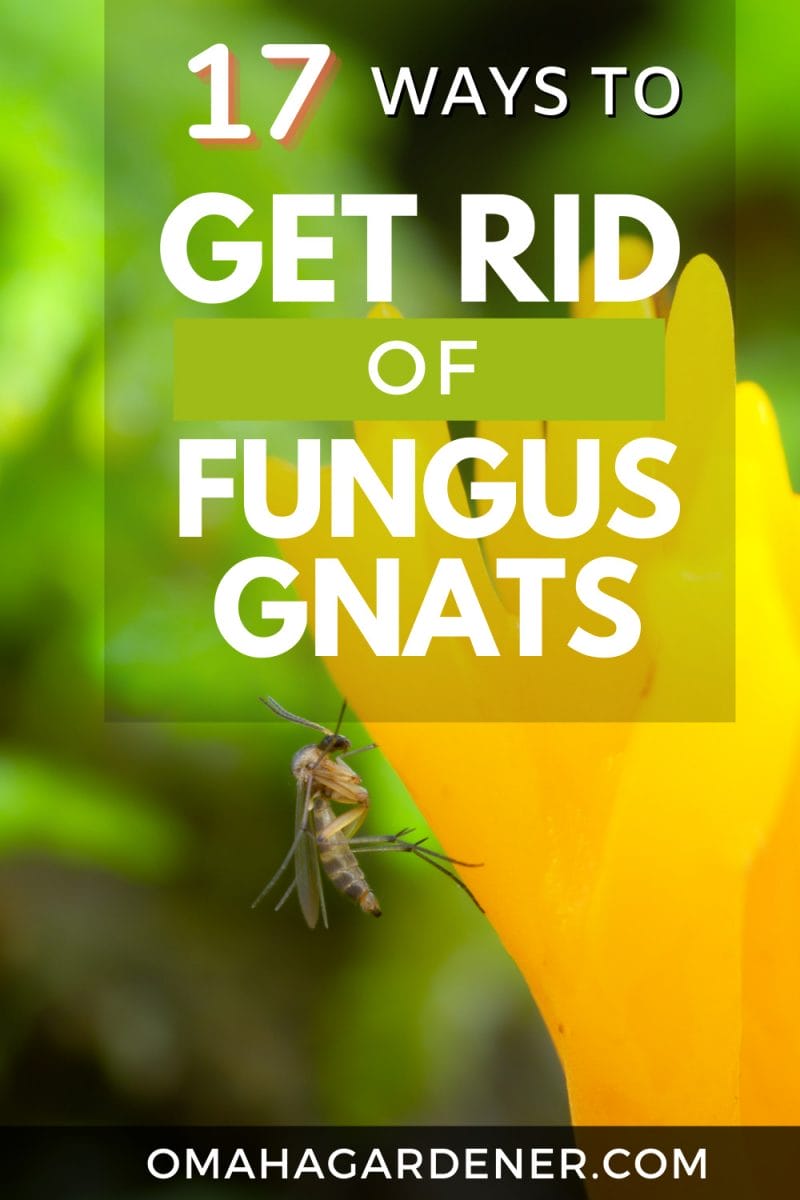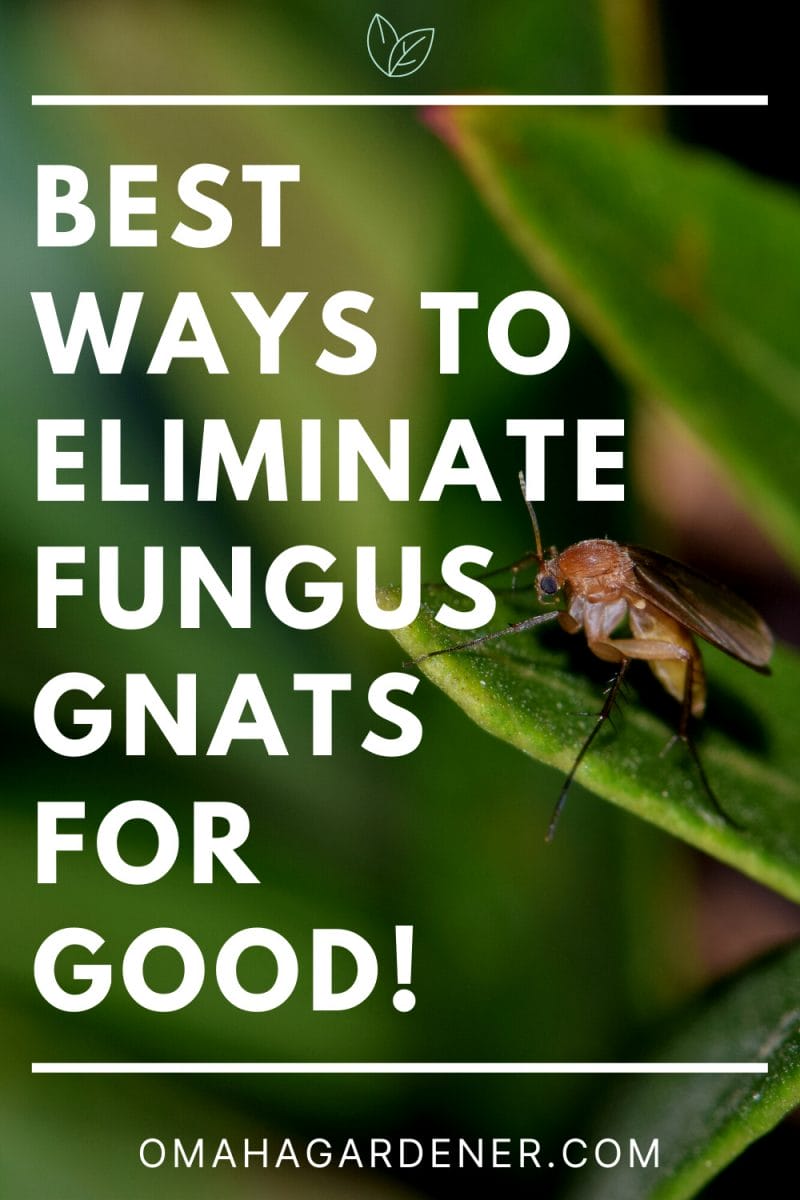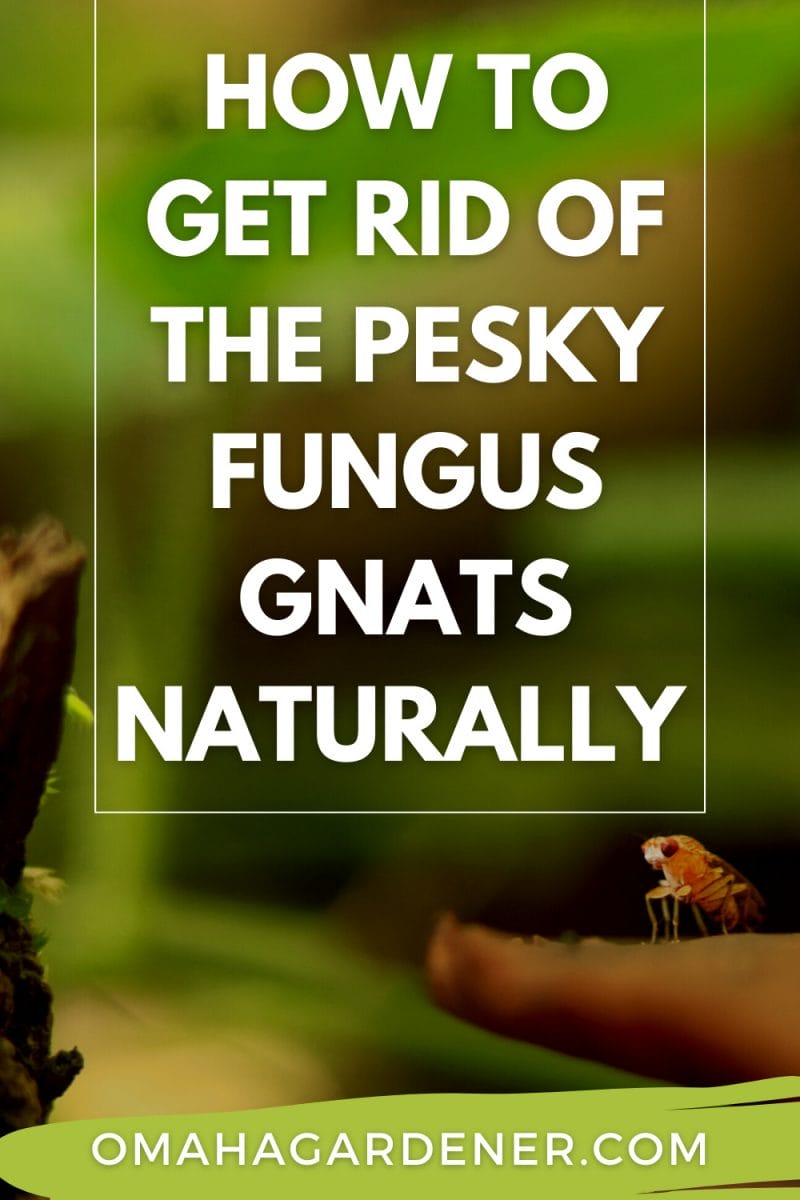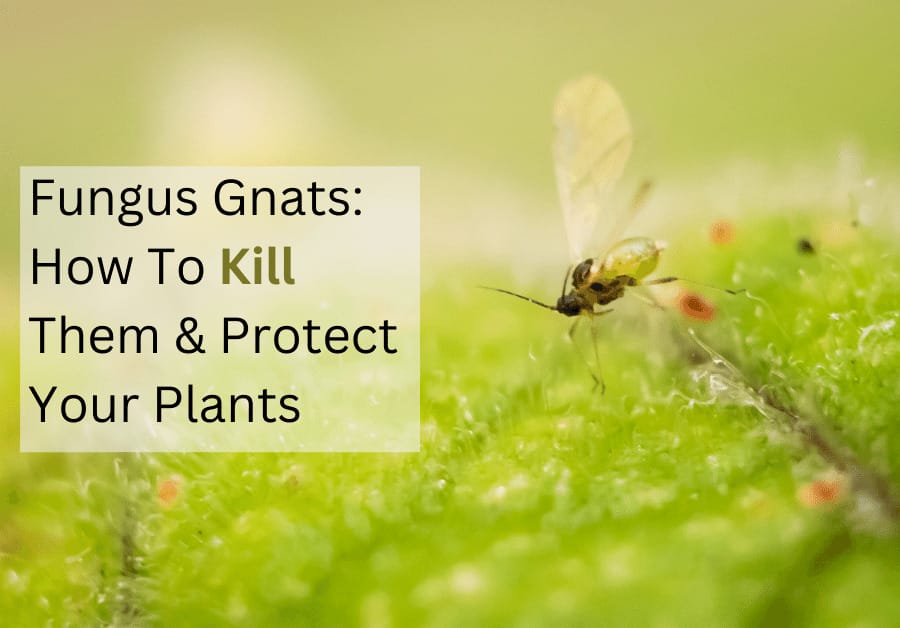Do you have a fungus gnat problem? If so, you're not alone. Fungus gnats are one of the most common pests in the United States. They can be a major nuisance, and they can also cause damage to your entire plant. Good News!! This article will discuss how to kill fungus gnats using organic or chemical methods.
If you've ever seen tiny black bugs hovering around your house, they're most likely fungus gnats. The flies that are attracted to damp conditions are known as fungus gnats. They are found near potted plants because of the moist soil that provides an ideal environment for their development.
If so, you're not alone. Fungus gnats are one of the most common pests in the United States. They can be a major nuisance, and they can also cause damage to your entire plant. Good News!! This article will discuss how to kill fungus gnats using organic or chemical methods. Now… Let's dive into this pest and determine possible solutions.
Table of Contents
Earlier this year, I personally experienced an infestation of fungus gnats in my grow room while prepping for my spring vegetable garden. My garage has a utility room that doubles as my grow room. Each year I sow my seeds in trays and monitor the water, light, humidity, and all the gardening geeky stuff. I didn't address the issue quickly enough, and they multiplied rapidly. At which point I realized I had a fungus gnat problem. It wasn't an overnight process, but I regained control.
What are Fungus Gnats
Fungus gnats are small, dark-colored insects that are closely related to mosquitoes. They get their name because they're often found near fungus and other organic matter. The scientific name for fungus gnats is Sciaridae.
Both adults and larvae feed on decaying organic matter and can damage plants. The larvae are 1/8th to ¼ inch long and have a whitish color, and can be found in the soil beneath decaying vegetation, compost piles, or manure. The larvae can cause root pruning and even death in seedlings. The species is most common in wet habitats such as marshes, bogs, and ponds. Fungus gnats also occur in wooded areas, parks, and gardens. The fungus gnat has a very short lifespan, usually lasting only one to two weeks.
Fungus gnat adults are typically found in the summer months from June through August. The adults feed on plant nectar and are attracted to lights at night. Fungus gnats can be a major nuisance if not taken care of. They're known for their constant buzzing, which can be challenging to eliminate once they've infested an area.
What is the Fungus Gnats Life cycle and lifespan
The fungus gnat's life cycle develops through four stages— fungus gnat eggs, larva, pupa, and adult. The tiny eggs and oblong pupae appear in damp organic media where female larvae feed. The tiny adults have a brownish-black body with pale markings and are about 2.50 inches long. The adults lifespan is usually only 7-9 days.
Natural Solutions to Kill Fungus Gnats
There are various ways to kill fungus gnats, depending on where they are located and what type of insecticide you have available. They can be controlled by destroying their habitat with traps and by putting out food sources that will attract predators. Here are seventeen (17) ways to get rid of fungus gnats and fruit flies:
1. Yellow Sticky Traps (sticky fly traps)
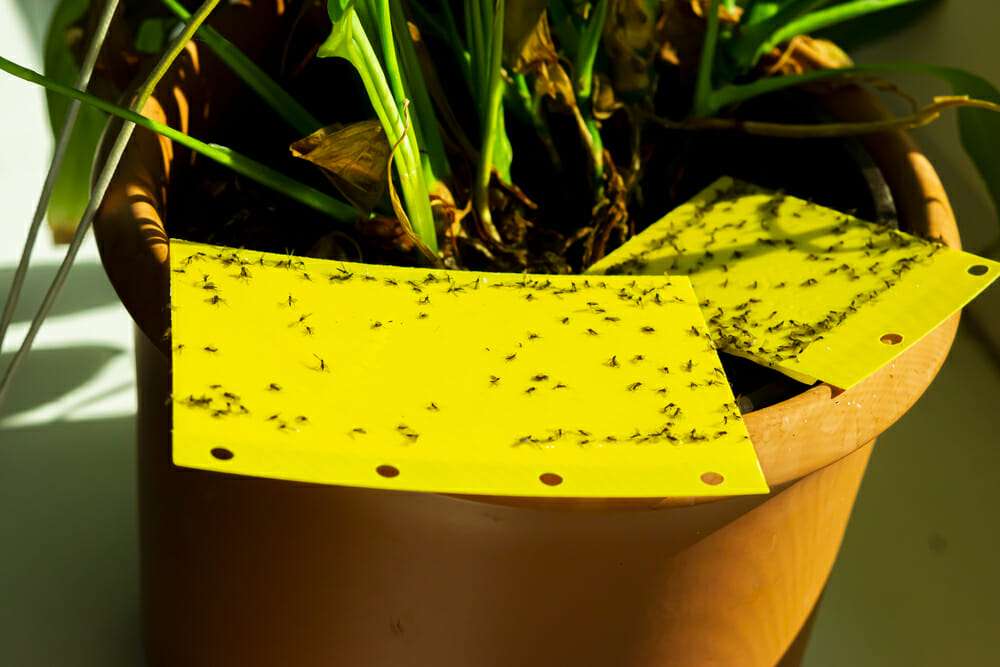
One of the best ways to kill fungus gnats is by using yellow sticky cards (traps). These are available at most hardware and online. They work by attracting the gnats with their bright yellow color. The gnats then get stuck to the adhesive on the trap and die. Fungus gnat adults are hard to control because they can lay eggs in moist soil.
2. Homemade Wine Trap
Make your trap using a bit of wine, plastic wrap, and a toothpick. Pour a small amount of wine or cooking wine into a bowl and cover it with plastic wrap. Punch a few holes in the plastic wrap. Make sure the wrap is tight so that the gnats can't escape. Then, set the trap near your plants and wait for the gnats to be attracted to the wine. They'll fly in and then get stuck, drowning in the wine.
3. Cinnamon
Cinnamon is a great way to get rid of fungus gnats naturally. Simply sprinkle cinnamon around the base of your plants, and the gnats will stay away. PRO TIP: You can also add a bit of cinnamon to your soil before planting to help prevent fungus gnats from becoming a problem in the first place.
4. Neem Oil Spray
Neem oil is a natural insecticide that's very effective at killing fungus gnats. Simply mix a few drops of neem oil with water in a spray bottle and spritz it on your plant leaves and soil. The gnats will be killed on contact. Also, spray the soil's surface. Every gardener should have neem oil in their toolbox.
5. Homemade Insecticidal Soap
You can also make your insecticidal soap to kill fungus gnats. Simply mix equal parts of liquid dish soap and water in a bowl. Then, put the homemade mixture into a spray bottle and spritz it around your plants. The soap will kill the gnats on contact.
6. Diatomaceous Earth
Diatomaceous earth is a natural substance that's very effective at killing insects. Simply sprinkle it around your plants, and the gnats will die when they come into contact with it. Diatomaceous earth is made from the fossilized remains of tiny marine organisms called diatoms, ground into a fine powder.
7. Silicon Dioxide Gel
Silicon dioxide gel is another great way to kill fungus gnats. Simply mix the gel with water in a bowl and set it near your plants. The gnats will fly into the bowl and get trapped in the gel, killing them.
8. Hairspray Trap
You can also make a trap using hairspray and plastic wrap. Simply cover a bowl with plastic wrap and then spray the plastic wrap with hairspray. The gnats will be attracted to the hair spray and fly into the bowl, where they'll get stuck and die.
9. Remove Potential Sources Of Moisture (Moist Environments)
If fungus gnats are present in your home, we recommend you take the following action:
- Remove any potential moisture sources they may be breeding in. This may include repairing any leaks, drainage problems, or condensation issues.
- Drain any standing water that may be present in plant saucers.
- Monitor your watering. Let the top of the soil dry because moist soil is a perfect environment to attract fungus gnats and lay eggs. Also, overwatering your plants can lead to root damage or root rot.
- We recommend you water plants on a schedule.
- Finally, for fungus gnat infestation, consider using a dehumidifier to help reduce the moisture levels that they thrive in.
10. Remove Their Food Source
We know that fungus gnats are attracted to fungus and decaying organic matter, so removing their food source is another way to get rid of them. This can be done by regularly cleaning up any decaying leaves or other organic debris around your plants.
11. Hydrogen Peroxide

Hydrogen peroxide can be used as a natural fungicide to kill fungus gnats. It can be applied directly to the soil of infested plants or used as a root drench.
To make a hydrogen peroxide root drench, mix one part hydrogen peroxide with two parts water. The best way to apply hydrogen peroxide solution is to saturate it until it reaches the plant roots. Afterward, allow the plant to dry.
You can also add a few drops of hydrogen peroxide to a spray bottle filled with water and use it to mist the leaves of infested plants. This will help to kill adult fungus gnats and their larvae.
Hydrogen peroxide can also make a trap for adult fungus gnats. To do this, mix one part hydrogen peroxide with two parts water in a bowl and place it near infested plants. Adult gnats will be attracted to the solution in the bowl and drown when they try to drink the mixture.
Tip: It is safe to use regular hydrogen peroxide in the brown bottle from your local pharmacy
12. Apple Cider Vinegar Traps
Since apple cider vinegar has a pungent pseudo-rotten smell, it is attractive to adult fungus Mix one part apple cider vinegar with two parts water and a few drops of liquid dish soap in a cup or bowl and stage near infested plants. The adult gnats will be attracted to the bowl and drow.
Spritz
You can also add a few drops of apple cider vinegar to a spray bottle filled with water and use it to mist the leaves of infested plants. This will help to kill adult fungus gnats and their larvae.
Root Drench
Gardeners use Apple cider vinegar as a fungicide to kill fungus gnats. It can be applied directly to the soil of infested plants or used as a root drench.
To make an apple cider vinegar root drench, mix one part apple cider vinegar with two parts water and apply it to the roots of infested plants.
13. Beneficial Insects
A few different types of beneficial insects can be used to help control fungus gnat populations. These include predatory mites, fungus gnat larvae-eating nematodes, and parasitic wasps. Predatory mites are tiny spiders that feed on fungus gnats and other small insects.
Fungus gnat beneficial nematodes are microscopic worms that kill fungus gnat larvae by parasitizing them.
Parasitic wasps are small insects that lay their eggs inside of fungus gnat larvae. The wasp larva then hatches and eats the fungus gnat larvae from the inside out.
These beneficial insects can be purchased online or at your local nursery or garden centers.
Once you have obtained the beneficial insects, release them near infested plants according to the package directions.
Release them in the evening when fungus gnat activity is highest and keep an eye on the infested area. We don’t advise using this option indoors.
14. Physical Controls
A few different physical controls can be used to help get rid of fungus gnats. You can also try placing a piece of sticky tape or paper over the drainage holes of infested pots to help catch fungus gnats as they try to fly out.
Another physical control that can be used is to place a small fan near infested plants. The moving air will help to keep fungus gnats away from the plants and make it harder for them to lay their eggs.
While physical controls can be effective, they should be combined with other methods to achieve the best results. Lastly, mulching the soil around plants with organic material, such as peat moss or compost, will help to repel fungus gnats by creating an environment that is not suitable for them. The acidic nature of organic mulch helps to prevent fungus gnats from developing and reproducing.
PRO TIP: if you’re bringing a plant from outdoors to indoors for the winter months,
- Remove the top inch of soil (top layer of soil)
- Use one of the drench methods mentioned above
- Top the plant with sand (adding 1-2 inches) This will help to prevent fungus gnats from being able to lay their eggs in the soil.
15. Sterilize Potting Soil
Many gardeners purchase potting soil from big box stores or nurseries to plant their indoor plants and usually use the potting mix directly out of the bag. Consider sterilizing your potting soil before you use it. This will help reduce/eliminate diseases and fungus gnats in the soil.
If you have houseplants, consider moving them outdoors during summer to help starve the fungus gnats in your home.
House plants are notorious for being a breeding ground for pests.
There are a few things you can do to help prevent gnats in houseplants:
- Inspect your plants regularly for signs of pests, such as holes in leaves, webbing, or eggs.
- If you see any pests, immediately isolate the affected plant from your other plants.
- Treat the affected plant with an appropriate treatment
- Keep your plants healthy by giving them the proper care, including watering, fertilizing, and providing adequate light. Healthy plants are less likely to be attacked by pests.
Chemical Solutions to Kill Fungus Gnats
16. Apply Biological Controls
A few different biological controls can be used to help get rid of fungus gnats. Bacillus Thuringiensis, is a bacteria that kills fungus gnat larvae. This bacteria can be found in products like Gnatrol and Dipel.
Another option is to use Beauveria bassiana, a living organism fungus that kills fungus gnats and other insects. This fungus can be found in products like Mycotrol.
These products can be found online or at your local nursery or garden center. Follow the package directions when applying them to infested plants.
17. Insecticides
Insecticide sprays can also kill fungus gnats, but they should be used as a last resort since they can harm beneficial insects and other animals.
- There are a few different types of insecticides that can be used to kill fungus gnats, including pyrethrin-based sprays, neem oil, and horticultural oil.
- Pyrethrin-based insecticides are derived from the chrysanthemum flower and are effective against many insects, including fungus gnats.
- Horticultural oil is a refined petroleum product that can smother and kill fungus gnats and other insects when applied to plants.
Frequently Asked Questions
There are always questions about this topic. Therefore, I want to address a few frequently asked questions.
Are Fungus Gnats Harmful to People or pets?
Fungus gnats are not harmful to humans or pets. They are more of an annoyance than anything else. These annoying little gnats do not bite or sting.
Why do I suddenly have fungus gnats?
Fungus gnats may suddenly appear in your garden due to overwatering, moist soil, or decaying organic matter.
Can Plants Survive Fungus Gnats?
Plants can survive fungus gnats. The gnats do not affect the health of plants or flowers. However, these annoying little gnats can be a nuisance and are often very difficult to eliminate completely. Control is difficult because of the large numbers and the wide range of susceptible species.
What Kind of Damage Do Fungus Gnats Create?
Fungus gnats can cause life-threatening damage to your plants. The larvae of these insects are drawn to and feed on the roots of plants, which can eventually kill the plant. This alone is enough to get rid this pest. In addition, the larvae produce a sticky substance that can clog up plant roots and prevent them from absorbing water and nutrients.
Conclusion
In conclusion, there are many ways to get rid of fungus gnats and protect your plants. Some methods are more effective than others, but it depends on what you're comfortable with and what works best for your situation. Whichever method you choose, just be sure to be consistent and patient, and you should see results in no time.
